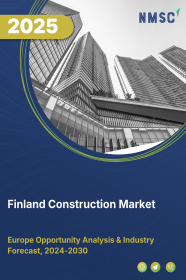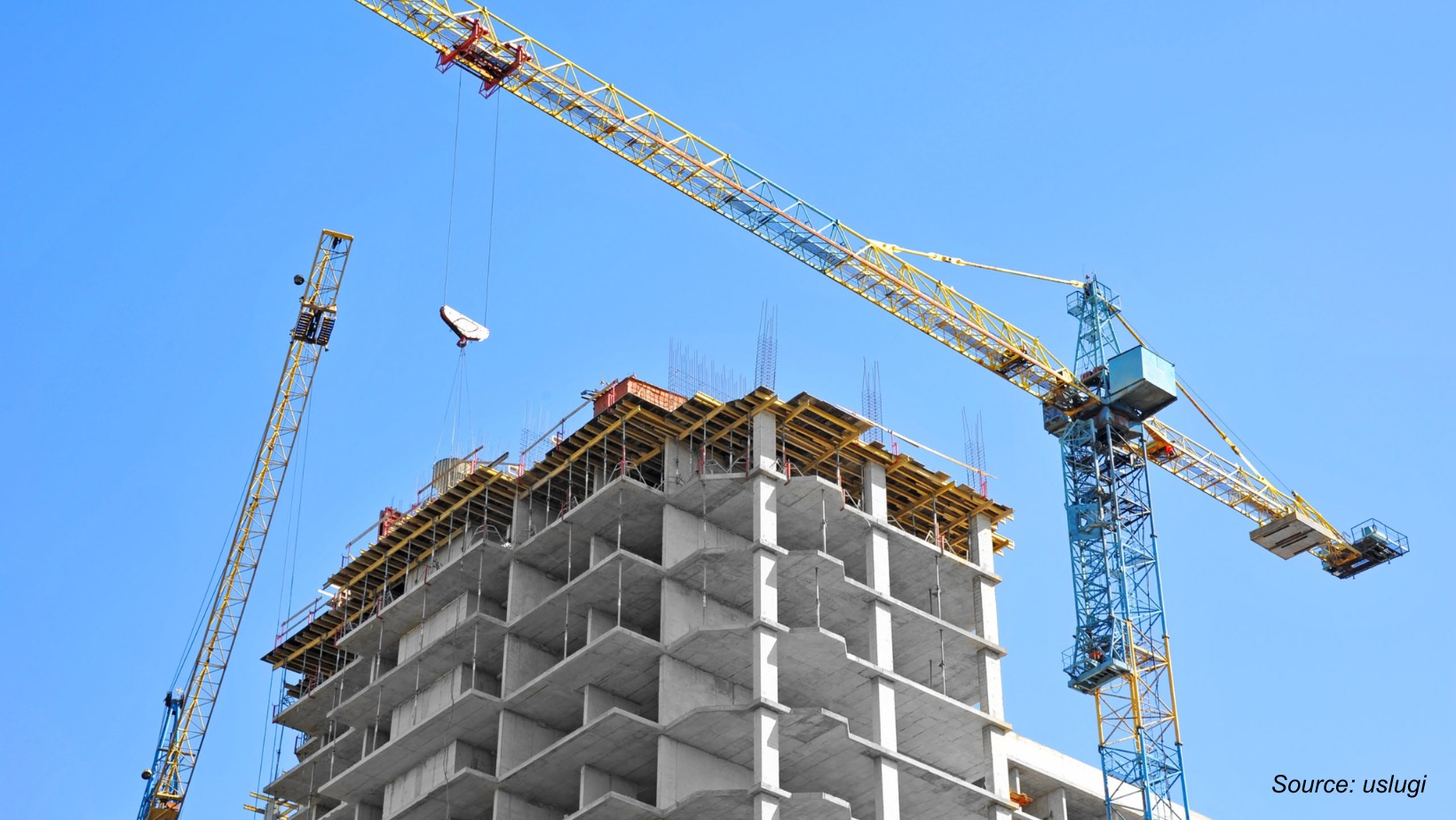
Finland Construction Market By Type (Renovation, and New Construction), By Sector (Real Estate, Infrastructure, Industrial), By Construction Method (Traditional Construction, Prefabricated/Modular Construction, 3D Printed Construction, and Green/Sustainable Construction), By Type of Contractor (Small Contractor, Medium Contractor, and Large Contractor)– Industry Trends and Forecast, 2025–2030.
Industry: Construction & Manufacturing | Publish Date: 09-Oct-2025 | No of Pages: 84 | No. of Tables: 117 | No. of Figures: 62 | Format: PDF | Report Code : CM2205
Finland Construction Industry Overview
The Finland Construction Market size was valued at USD 40.54 billion in 2024, and is projected to grow to USD 45.48 billion by 2025. Additionally, the industry is expected to continue its growth trajectory, reaching USD 51.96 billion by 2030, with a CAGR of 2.7% from 2025 to 2030.
This industry is experiencing steady growth, driven by a strong focus on renewable energy infrastructure projects such as large-scale solar farms and energy facility upgrades. Population growth and urbanization are also contributing to increased demand for housing, commercial spaces, and public services, boosting construction activities.
However, the market faces challenges from complex regulatory frameworks and lengthy permitting processes, which can delay projects and increase costs. Despite these hurdles, the sector is benefiting from digital transformation, particularly the adoption of Building Information Modeling (BIM) and technologies like AI and IoT, which enhance efficiency and coordination in project execution.
Renewable Energy Infrastructure Initiatives Fuel Market Growth
Finland’s construction sector is gaining strong momentum from large-scale renewable energy developments. EU-backed funding is driving the rollout of solar photovoltaic projects across multiple regions, adding hundreds of megawatts of new capacity. At the same time, grid-scale battery energy storage systems are expanding rapidly to enhance flexibility and enable higher integration of renewables. Green hydrogen has emerged as a new growth frontier, highlighted by the commissioning of Finland’s first industrial-scale plant and several additional projects under planning. Together, these investments are stimulating demand for the construction of generation, storage, and transmission infrastructure, creating significant opportunities for contractors and regional development.
Urban Population Growth Sustains Construction Demand
Finland’s population growth is modest, but immigration and natural increase are expected to lift the total to 5.6–5.65 million by mid-2025. Urbanization remains strong, with the Helsinki metropolitan area and other major cities becoming increasingly dense. This expansion is driving demand for new housing, public services, transport networks, and utilities. Demographic shifts—most notably an aging population and evolving household structures—are also creating demand for healthcare facilities, senior housing, and the renovation of the existing building stock. Together, these factors are sustaining steady construction activity across residential, commercial, and social infrastructure segments.
Complex Regulations and Approval Delays Hinder Growth
Finland’s construction market continues to face headwinds from an increasingly stringent regulatory environment. Major infrastructure and renewable energy projects must comply with multiple layers of permitting, environmental reviews, and building code requirements across municipal, regional, and national authorities. Lengthy approval timelines and evolving sustainability standards add further uncertainty for developers. At the same time, grid interconnection rules for renewable and hydrogen projects are tightening, leading to higher costs and more complex project delivery. These challenges weigh most heavily on smaller contractors and private developers, limiting the pace of overall market growth.
Digitalization and Modern Methods Transform the Construction Landscape
Finland is accelerating the adoption of advanced construction technologies to improve efficiency and sustainability. Building Information Modelling (BIM) is increasingly mandated in public procurement, while modular and prefabricated solutions are gaining traction in housing, commercial, and energy projects. These methods address labor shortages, shorten delivery times, and improve environmental performance. In parallel, the rise of large-scale energy storage and smart infrastructure projects is driving demand for digital solutions such as IoT, AI, and predictive maintenance platforms. Collectively, these innovations are reshaping Finland’s construction sector, offering contractors and developers significant opportunities to differentiate and scale.
Competitive Landscape
The key players operating in the Finland construction industry include Shell, Keller Group plc, LEONHARD WEISS, YIT OYJ, NCC, Skanska, Peab Oy, Fira Group, Hartela Companies Ltd, Lapti Construction Company Ltd., Projektinuotit Oy, SRV Group Plc, Kreate Group Oyj, Sitowise Group Oyj, Suomen Rakennusurakka Oy, and others.
Finland Construction Market Key Segments
By Type
-
Renovation
-
New Construction
By Sector
-
Real Estate
-
Residential
-
Affordable
-
Luxury
-
-
Commercial
-
Retail Buildings
-
Office Buildings
-
Hospitality
-
Healthcare Facilities
-
Educational Institutes
-
Entertainment Ventures
-
-
-
Infrastructure
-
Transportation
-
Airport
-
Port
-
Rail
-
Road
-
-
Water and Wastewater
-
Energy
-
Telecommunication
-
-
Industrial
-
Manufacturing Plant
-
Warehouses
-
Power Plants
-
Oil Refineries
-
Chemical Plants
-
By Construction Method
-
Traditional Construction
-
Prefabricated/Modular Construction
-
3D Printed Construction
-
Green/Sustainable Construction
By Type of Contractor
-
Small Contractor
-
Medium Contractor
-
Large Contractor
Key Players
-
Shell
-
Keller Group plc
-
LEONHARD WEISS
-
YIT OYJ
-
NCC
-
Skanska
-
Peab Oy
-
Fira Group
-
Hartela Companies Ltd
-
Lapti Construction Company Ltd.
-
Projektinuotit Oy
-
SRV Group Plc
-
Kreate Group Oyj
-
Sitowise Group Oyj
-
Suomen Rakennusurakka Oy
REPORT SCOPE AND SEGMENTATION:
|
Parameters |
Details |
|
Market Size in 2024 |
USD 40.54 Billion |
|
Revenue Forecast in 2030 |
USD 51.96 Billion |
|
Growth Rate |
CAGR of 2.7% from 2025 to 2030 |
|
Analysis Period |
2024–2030 |
|
Base Year Considered |
2024 |
|
Forecast Period |
2025–2030 |
|
Market Size Estimation |
Billion (USD) |
|
Growth Factors |
|
|
Companies Profiled |
15 |
|
Market Share |
Available for 10 companies |
|
Customization Scope |
Free customization (equivalent up to 80 working hours of analysts) after purchase. Addition or alteration to country, regional, and segment scope. |
|
Pricing and Purchase Options |
Avail customized purchase options to meet your exact research needs. |

















 Speak to Our Analyst
Speak to Our Analyst

























